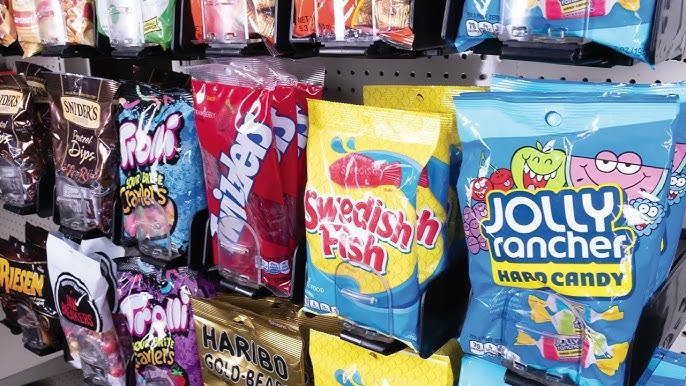Small stores are masters of doing more with less. Less space. Less staff. Less inventory. But the one thing they can’t afford to cut corners on? Shelf organization. That’s where shelf pusher systems come in — helping small retailers create a cleaner, more efficient, and more profitable display setup.
Shelf pusher systems are mechanical or gravity-based tools that keep products automatically aligned and front-facing on shelves, making stores look neat and boosting sales without extra labor.
If you’re running a small retail business, your margins matter. Shelf pushers might look like just another fixture, but they quietly solve some of the most annoying retail problems — messy displays, time-consuming restocks, and missed sales from empty spots. Ready to see which ones are worth your time?
What Is a Shelf Pusher System?
Shelf pusher systems are devices that keep products in a tidy, front-facing position on display shelves. They use mechanical springs or gravity to automatically push items forward when one is taken. This means the shelf always looks full and organized, even without constant attention.
They are widely used in retail to improve product visibility, reduce labor, and enhance the shopping experience — especially in narrow aisles or limited shelf space.
Let’s break it down further so you can see why this tool is not just for big stores.
Types of Shelf Pusher Systems
| Type | Mechanism | Best For |
|---|---|---|
| Spring-loaded | Coiled spring push | Beverage cans, cosmetics |
| Gravity-fed mat | Sloped track system | Refrigerated goods, dairy |
| Manual pusher | User repositioned | Slow-moving items |
Common Use Cases
- Convenience stores with fast-moving snacks
- Pharmacies for medicine bottles
- Fridge sections in supermarkets
- Mini marts with limited staff
These systems remove the need for frequent shelf-tidying, saving hours every week. For small retailers with limited manpower, that’s a big win.
Why Do Small Retailers Need Shelf Pushers?
Keeping displays full is not just about looks — it’s about sales. When shelves are messy or empty-looking, customers hesitate. Worse, they may think you’re out of stock.
Small retailers use shelf pushers to maintain clean, well-stocked displays without needing to constantly rearrange products manually. This creates better shopper experiences and drives more impulse buys.
Here’s where it gets interesting…
Key Challenges Faced by Small Stores
| Problem | Impact | How Shelf Pushers Help |
|---|---|---|
| Limited staffing | Fewer people to restock shelves | Pushers automate product facing |
| Narrow aisle space | Less room to browse | Neat rows prevent clutter |
| Inconsistent merchandising | Products get buried | Keeps all items visible |
Bonus Advantage: Loss Prevention
Some small stores report that front-facing products help reduce theft. Why? Because customers and staff can clearly see what’s on the shelf — no place to hide sneaky grabs.
How Do Shelf Pushers Improve Product Visibility?
Product visibility isn’t just about design — it’s directly tied to how fast something sells. Items hidden in the back don’t move. Shoppers often choose what’s easiest to grab.
Shelf pushers make sure every product is front and center, making it more likely to catch attention and be picked up.
Now let’s get into the mechanics.
Eye-Level = Buy-Level
When products are neatly aligned and at the front of the shelf, they’re more likely to fall into the shopper’s line of sight. This increases interaction and chances of purchase.
Effects on Shopper Behavior
| Shelf Appearance | Shopper Reaction |
|---|---|
| Empty/messy shelves | Avoids buying, assumes out-of-stock |
| Full and neat shelves | More trust, higher likelihood to buy |
| Front-facing items | Easier grab = faster decision |
Even a few centimeters of visibility improvement can push conversion up. That’s why this small hardware upgrade pays off quickly.
Which Products Work Best With Shelf Pushers?
Not all products are created equal — and not all work well with pushers. Understanding which SKUs benefit most helps you decide where to install first.
Shelf pushers are most effective with lightweight, packaged, uniform items like drinks, packaged snacks, cosmetics, and personal care goods.
But let’s dig deeper.
Product Types That Fit Well
- Cans and bottles: Soda, juice, energy drinks
- Snack bars: Uniform packaging makes it ideal
- Cosmetics: Lipsticks, foundation, nail polish
- Medicine boxes: Especially cold & flu remedies
- Dairy: Yogurts, milk drinks in gravity-feed coolers
Things to Watch Out For
| Product Trait | Suitability for Pushers |
|---|---|
| Heavy items | May overpower spring mechanism |
| Odd shapes | Can jam the pushing system |
| Fragile packaging | Risk of product damage |
So when planning implementation, it’s smart to run a pilot with 1-2 categories that are high-volume and uniform.
What Are the Top Shelf Pusher Materials?
Here’s the kicker — materials matter. Cheap plastic systems might break or become misaligned, especially in high-use areas.
The most common materials used in shelf pushers are PET, ABS, and PVC. Each has its strengths depending on your store environment and product load.
Let’s compare.
Material Comparison Table
| Material | Strength | Flexibility | Clarity | Best For |
|---|---|---|---|---|
| PET | High durability | Medium | Clear | Coolers, cosmetics, cold zones |
| ABS | Very strong | Low | Opaque | Heavy products, rough handling |
| PVC | Moderate | High | Slight | Lightweight, low-traffic zones |
Novaday Insight
At Novaday, we specialize in PET injection molding, which offers excellent clarity and durability, ideal for refrigerated zones and high-visibility categories.
How Do Shelf Pushers Affect Restocking Efficiency?
Time is money — and restocking shelves eats up a lot of it. Without pushers, products need to be manually faced every few hours.
Shelf pushers reduce labor time spent on front-facing and allow staff to refill from the back with confidence that the system will do the rest.
Let’s talk numbers.
Time Saved Per Category
| Shelf Type | Time to Face Manually | With Pusher System | Labor Saved per Day |
|---|---|---|---|
| Snack shelf | 20 mins | 5 mins | 75% saved |
| Beverage fridge | 25 mins | 7 mins | 72% saved |
| Cosmetics display | 30 mins | 10 mins | 66% saved |
Multiply this across multiple aisles, and you’re easily reclaiming hours of staff time daily — hours you can redirect to customer service or cleaning.
Are Spring-Loaded or Gravity Pushers Better?
There’s no one-size-fits-all here. Each system type has its perks depending on the product type, shelf angle, and user expectations.
Spring-loaded pushers are great for flat shelves and tight arrangements. Gravity pushers excel in coolers and inclined shelves.
Let’s break that down with a side-by-side view.
Pros and Cons Table
| Type | Pros | Cons |
|---|---|---|
| Spring-loaded | Flat shelf friendly, easy install | Needs resetting if product jam |
| Gravity-fed | Low maintenance, coolers ideal | Needs angled shelf |
| Manual slide | Simple design | High labor cost, not auto-facing |
When to Use Which?
Use gravity mats for refrigerated goods — they work without any moving parts and are less likely to break. Use spring pushers for cosmetics or boxed food that sit on flat shelves.
What Size Shelf Pusher Fits My Display Shelves?
Fit matters. Too wide and the product wobbles. Too narrow and it gets stuck. Choosing the right size means fewer headaches.
Measure your shelf depth and product width carefully, then select a pusher channel that fits snugly and supports the product weight.
Let’s make it easy.
How to Choose the Right Size
- Measure product width (including packaging)
- Measure shelf depth (front to back)
- Choose pusher width that is 1-2 mm wider than product
- Pick spring force based on product weight
Example Table
| Product Type | Width (mm) | Recommended Pusher Width | Spring Type |
|---|---|---|---|
| Energy drink can | 66 | 68-70 | Medium tension |
| Snack bar | 40 | 42-44 | Low tension |
| Face cream jar | 55 | 57-59 | High tension |
Can Shelf Pushers Be Customized for Branding?
Absolutely. That’s one of the strongest plays small retailers can make — turning hardware into branding.
Shelf pushers can be customized with logos, color matching, and even integrated lighting or signage to create a cohesive brand look.
This is where design meets function.
Customization Options
- Color-coded dividers
- Printed brand logos on pusher faces
- QR codes or promo labels
- Integrated ESL mounts
If you’re doing OEM/ODM, branding shelf pushers is a simple way to make a display 100% your own.
Conclusion
Shelf pusher systems are a powerful yet often overlooked tool in retail. For small retailers, they save labor, improve presentation, and nudge up sales — all without breaking the bank. Whether you’re dealing with cluttered shelves, low staffing, or product gaps, the right pusher system might be the easiest upgrade you make this year. Thanks for reading — and if you’re ready to try a system that fits your store, let’s chat.



